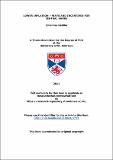Files in this item
Lower inflation : ways and incentives for central banks
Item metadata
| dc.contributor.advisor | Nolan, Charles | |
| dc.contributor.author | Geissler, Johannes | |
| dc.coverage.spatial | xi, 198 | en_US |
| dc.date.accessioned | 2011-03-29T10:32:51Z | |
| dc.date.available | 2011-03-29T10:32:51Z | |
| dc.date.issued | 2011 | |
| dc.identifier.uri | https://hdl.handle.net/10023/1719 | |
| dc.description.abstract | This thesis is a technical inquiry into remedies for high inflation. In its center there is the usual tradeoff between inflation aversion on the one hand and some benefit from inflation via Phillips curve effects on the other hand. Most remarkable and pioneering work for us is the famous Barro-Gordon model - see (Barro & Gordon 1983a) respectively (Barro & Gordon 1983b). Parts of this model form the basis of our work here. Though being well known the discretionary equilibrium is suboptimal the question arises how to overcome this. We will introduce four different models, each of them giving a different perspective and way of thinking. Each model shows a (sometimes slightly) different way a central banker might deliver lower inflation than the one shot Barro-Gordon game at a first glance would suggest. To cut a long story short we provide a number of reasons for believing that the purely discretionary equilibrium may be rarely observed in real life. Further the thesis provides new insights for derivative pricing theories. In particular, the potential role of financial markets and instruments will be a major focus. We investigate how such instruments can be used for monetary policy. On the contrary these financial securities have strong influence on the behavior of the central bank. Taking this into account in chapters 3 and 4 we come up with a new method of pricing inflation linked derivatives. The latter to the best of our knowledge has never been done before - (Persson, Persson & Svenson 2006), as one of very view economic works taking into account financial markets, is purely focused on the social planer's problem. A purely game theoretic approach is done in chapter 2 to change the original Barro-Gordon. Here we deviate from a purely rational and purely one period wise thinking. Finally in chapter 5 we model an asymmetric information situation where the central banker faces a trade off between his current objective on the one hand and benefit arising from not perfectly informed agents on the other hand. In that sense the central bank is also concerned about its reputation. | en_US |
| dc.language.iso | en | en_US |
| dc.publisher | University of St Andrews | |
| dc.subject.lcc | HG229.G4 | |
| dc.subject.lcsh | Inflation (Finance)--Econometric models | en_US |
| dc.subject.lcsh | Derivative securities--Prices--Mathematical models | en_US |
| dc.subject.lcsh | Banks and banking, Central | en_US |
| dc.subject.lcsh | Monetary policy | en_US |
| dc.title | Lower inflation : ways and incentives for central banks | en_US |
| dc.type | Thesis | en_US |
| dc.type.qualificationlevel | Doctoral | en_US |
| dc.type.qualificationname | PhD Doctor of Philosophy | en_US |
| dc.publisher.institution | The University of St Andrews | en_US |
This item appears in the following Collection(s)
Items in the St Andrews Research Repository are protected by copyright, with all rights reserved, unless otherwise indicated.

